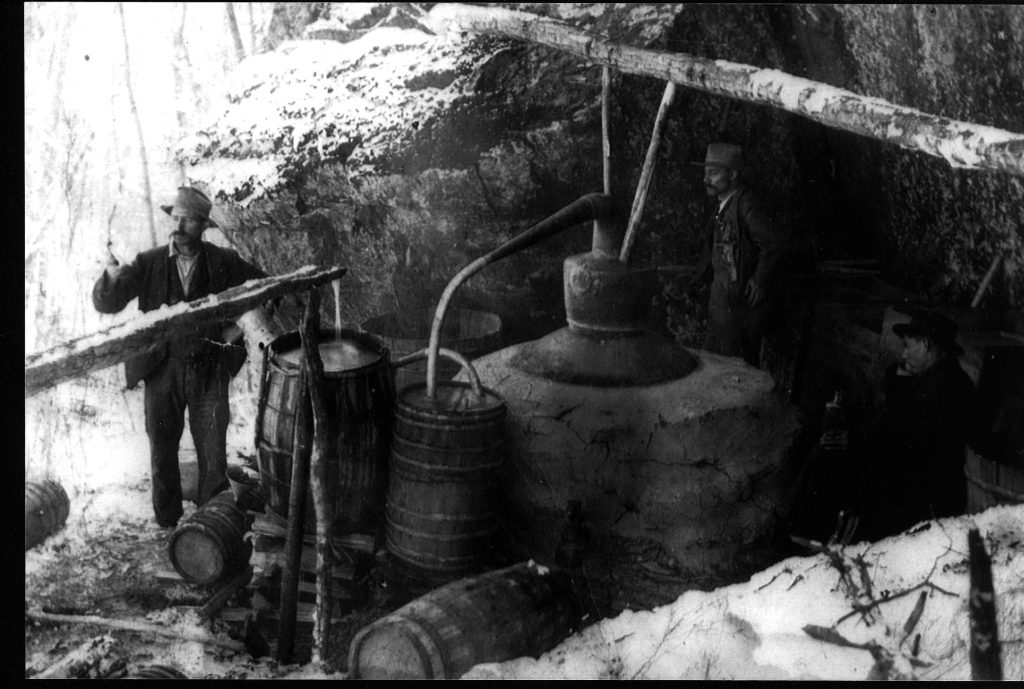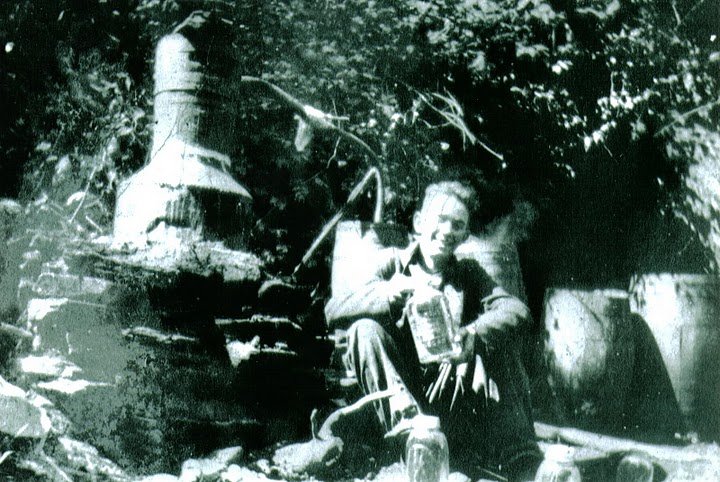Since the first settlement of Ashe County by Europeans, the production of whiskey has existed. However, this whiskey production has not always been illegal. For decades, citizens of Ashe County were able to legally produce hundreds of gallons of homemade alcohol. This was a common trait of western North Carolina counties. In 1840, for example, western North Carolina produced 31% of North Carolina’s total output of distilled liquor, even though the population of the region was only 14% of the state’s population. Of these 11 mountain counties, Ashe was one of the most prolific producers, and produced the fourth most alcohol of any county in the North Carolina mountains. Of course, these census numbers reflect the total produced by legal distilleries. However, throughout this same period, illegal producers of ‘moonshine’ were also churning out thousands of gallons of untaxed whiskey.

Trying to calculate the scope of the county’s moonshine ‘industry’ is difficult, as the nature of moonshine production is secretive. Although homemade liquor production has been legal at various times, the creation of untaxed liquor has almost always been against the law. However, given the modern interest in moonshine production, it is worth attempting to examine the scope and nature of illegal liquor production in Ashe County.
Most sources of information regarding moonshine are anecdotal: stories about wily moonshiners and hapless deputies are often told, retold, and sometimes invented, and cannot accurately be used to understand a broader picture of illegal liquor production. However, it is possible to gain some insight through newspapers. Newspapers have always been drawn to stories about confiscated moonshine stills, and, in the case of Ashe County’s Skyland Post, frequently ran front page stories about illegal stills. By using the nature and frequency of these stories as a window into the otherwise hidden world of moonshine production, an interesting story of illegal liquor in Ashe County comes into focus.
Perhaps driven by the Great Depression, one period which seems to have been especially active for moonshiners were the years leading up to World War II. Between 1935 and 1938, for example, 21 stills were reported as destroyed by Sheriff’s deputies in Ashe County. The locations of these stills demonstrate another interesting trend in Ashe County moonshining: the localization of production. Although the county is nearly 500 square miles, stills were not equally distributed. Areas around the major towns, as well as the northern and southern ends of the county seemed to have produced very little illegal liquor; by contrast, two areas in particular, Peak Creek and Pine Swamp, seem to have been the hotbeds of moonshine production during the depression. This was probably due to the fact that the county actually had only a relatively few moonshiners, who tended to favor areas near their homes and who may have taught nearby friends and neighbors to also construct stills of their own. This can be inferred by the limited number of arrests associated with moonshine production. For example, in the five years between 1936 and 1941, Lundy Darnell, who lived in the Peak Creek area, was arrested 4 times for violating the prohibition law.
It is interesting to note how the public perception of moonshine has changed over the years. Today, moonshine is often viewed nostalgically, with moonshiners celebrated as curators of a lost art, using the resources available to make a semi-honest living. However, newspaper accounts from the time demonstrate that moonshiners were viewed much more negatively. One account from a 1935 edition of the Skyland Post decries the ‘art’ of moonshining, saying “Look at what sort of stuff the younger set is turning out! . . .It’s described as a general mixture of water from the most convenient brook, sugar, molasses, just enough grain mash to assure fermentation, and whatever insects or mice chance to fall into the open vats.”
Because liquor sale and possession were totally illegal in Ashe County during the years before World War II, all the sins of alcohol could be easily laid at the feet of moonshiners and newspapers and religious leaders were always quick to point out that drunken drivers, public nuisances and violent criminals were all being fueled by illegal moonshine. The moonshiners themselves did little to burnish their image. They were known to sell jars of water to unsuspecting customers, assault officers, and drive recklessly. In May of 1938, moonshiners even purposely started a large forest fire in Pine Swamp to distract deputies closing in on a still site.
This disdain for moonshining itself does not seem to have translated into a lack of interest on the part of the local consumer. In fact, moonshiners seemed to have based their production around the demands of the county’s consumers. Twenty percent of all reported still captures occurred in the three weeks before Christmas, suggesting that moonshiners were largely responsible for local holiday spirits. One still, captured in Wagoner during June 1935, was believed to have been built solely to supply liquor to the large June meeting at Senter Primitive Baptist Church. The newspaper account notes the result of the raid on the still, observing that “in spite of the large crowd at Senter, it was one of the quietest and best behaved that has been there in years.”
Ashe County’s moonshine production seems to have reached a fever pitch in the early 1940s. In 1940, the Skyland Post reported the capture of 19 different stills in Ashe County. In 1941, 14 were destroyed by Sheriff Len Miller and his deputies. However, as quickly as this spike in moonshine production appeared, it vanished. Between 1942 and 1947, only five stills were reported as captured.
There are several possible explanations for this sudden disappearance of the moonshine industry in Ashe. One is that the few operators who were responsible for a disproportionately large amount of the production were arrested.
Another possible reason for the disappearance of captured stills could be World War II. The shortages posed by the war made liquor making materials like sugar and copper difficult, if not impossible to obtain. In fact, moonshining was quickly framed as an anti-American activity. An article from March of 1942 in the Skyland Post argued against the production of moonshine, noting that “the necessity of using ships for other cargoes than sugar should make it important to keep all sugar in legitimate channels.” The Ashe County Sheriff’s department contributed to this view of moonshining as something detracting from the war effort by donating all confiscated stills to scrap metal drives in an effort to reclaim the copper for the war effort.
Since World War II, moonshining in Ashe County has never fully disappeared, but it has gradually evolved from being market driven pursuit of a few criminal entrepreneurs to a romanticized outgrowth of folk culture. Seeing how Ashe County’s history of liquor production intersects with larger historical trends helps to unravel the reality of bootleg liquor from its sometimes misrepresented reality, hopefully providing a more sober view of local history.

My wife’s dad Howard Bare and uncle Roger Bare (older brother) were transporting moonshine from Wilkesboro to Chicago in late 30’s. Some time around 1938, they got the word that the NC Highway Patrol had an arrest warrant for Roger Bare, so the two of them went to Birch Creek, Idaho where they had uncle’s farming and sheep raising. The story is told they had a truck load of moonshine they buried (truck and all) in the forest north of Dubois, Idaho. To keep from getting caught they moved to the Salt Lake Valley to join another uncle working in the mines around Bingham, Utah. One day Roger Bare was stopped by the Salt City Police and they found the outstanding warrant from NC. It cost $1000 to get him out of jail. My wife was born in Salt Lake City, so it was moonshine that made it happen.